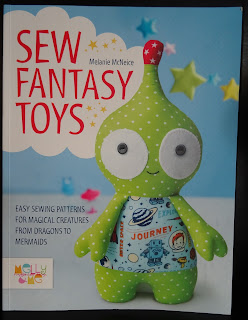Sorry it’s been so long since the last post, I have been
a busy bee! So this is going to be a tutorial for a crochet hook case. It links
with Granny
Square Blanket post. The friend I taught to crochet bought some hooks of
her own and I thought it would be a nice idea to make a case for her. I didn’t think
to write a tutorial for it so didn’t photograph the original, but after I made
it I realised how easy it was to make and made one for myself. It can easily be
made with 2 contrasting fat quarters (I also used a lightweight fusible interfacing
to add a little bit of rigidity but I don’t think it’s necessary) so here
we go:
I
started with this beautiful strawberry fabric and a red plain as contrast. The
main panel is 22cm by 28cm, cut one main and one plain fabric (and interfacing if
you’re going to use it). The crochet pocket is 13cm by 28cm cut the same as the
main panel. I also cut a strip of pain fabric 4cm by 56cm to use as the tie but
you could use ribbon or elastic if you like. I used a 1cm seam allowance
(included in the cut)
I’m going
to do this in three steps, I am confident it is that easy and won’t take much
time.
Step
One – the crochet pocket:
Take
the crochet pocket pieces right sides facing and stitch along the top only
(make sure if your pattern is directional it’s the right way round, I’ve done
this a few times and it’s so frustrating!!!). Turn it the right way round and
iron it flat. Take the plain fabric from the main fabric and line up the
crochet pocket with the bottom edge, pin in place. You want the right side of
the plain fabric and the right side of the crochet hook pocket looking at you.
On the bottom mark off your 1cm seam allowance on both sides and from there
mark in 2cm intervals. Stitch up to the top of the crochet pocket at each of
these marks except for the seam allowance marks (you will see this stitching so
you could use a nice contracting colour thread or one that will blend in).
Step Two
– Making and placing the tie.
Fold
the long strip of fabric in half and stitch the long edge and on short end. Turn
the right way round I use a crochet hook to help push it the right way round.
Iron flat and ladder stitch the open end. Or just use ribbon or elastic, your
choice! Fold it in half and then I tacked my tie just above the crochet hook pocket
so it lay flat over the crochet pocket (because you want it on the outside when
you’ve stitched it together).
Step
Three – Finishing (told you it was quick!)
So the
last thing is the patterns main panel fabric piece. Place this, right sides
facing, on top of the crochet pocket piece and pin in place. Stitch round the
whole piece laving small gap for turning. Turn case the right way round and
ladder stitch the gap closed. Iron the case. At this point you can either leave
is as is and fold the top over as and when you choose or you can do what I did
and fold the top down so it just covers the top of the crochet hooks and top
stitch down each side to secure, iron gain
if you do this.
There
you have it, one crochet hook case done!!!
It rolls up so you can pop it in your craft bag and it’s easy to take on the road without taking up much space
Here is the one I made for my friend, she loves owls!


















































